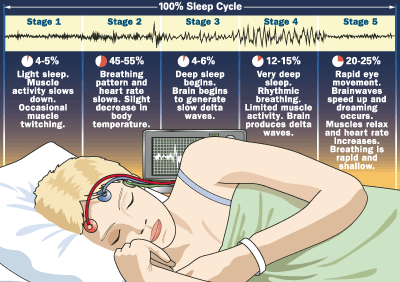Infradian and Ultradian Rhythms
Ultradian- spans less than a day. Infradian- lasts more
than a day but less than a year.
Ultradian
Rhythms (less than a day)
- · Sleep stages. 5 stages of sleep. First four is NREM sleep (non-rapid eye movement) and fifth stage is REM sleep (rapid eye movement). One sleep cycle goes through all five stages and 90 minutes. Stage 1 and 2- Change in the electrical activity of the brain. Brain produces typical pattern called beta wave. The more relaxed you get the slower your brain waves get and more regular, greater amplitude, alpha wave. As you go to sleep waves slow down further greater amplitude, theta wave, accompanied by short bursts of activity. Stage 3 and 4 have slower delta waves. These stages are called slow wave sleep (SWS). This stage hard to wake someone up. In deep sleep (SWS) body's physiological 'repair work' is undertaken and important biochemical processes such as growth hormones. Cycles continue in the night SWS getting shorter and REM getting longer.
- · Basic rest-activity cycle. Same 90 minute clock but now ticking through the day. Basic rest activity cycle (BRAC). Friedman and Fisher 1967 observed eating and drinking behaviour in a group of psychiatric patients over periods of 6 hrs. Found clear 90-minute cycle in eating and drinking behaviour.
Infradian
Rhythms (more than a day less than a year)
- · Monthly cycles- Female Menstrual cycle: caused by fluctuating hormone levels to regulate ovulation. Pituitary gland releases hormones which stimulate a follicle in one ovary to ripen an egg, triggers release of oestrogen. Once ripened, ruptured follicle secret's progesterone. Causes lining of womb to prepare for preg, increasing blood supply. 2 weeks after ovulation + no preg= reduced progesterone, causes lining to shed. Monthly rhythm in men: Empson 21 males had body temps and alertness measured over 42-102 days. Evidence in males for periodic variation, cycle of 20 days.
- · Seasonal affective disorder (SAD)- Infradian rhythms can occur once a year. Such as this depressive condition. Depressed during the winter because more darkness means less melatonin and less serotonin. Recover during summer, more melatonin, more serotonin. Research studies show melatonin and serotonin are secreted when its dark.
Evaluation
- · AO2 SLEEP STAGES: Issue in REM sleep studies is assumption that it is dreaming sleep. Dement and Kleitman 1957 first demonstrated the link. They woke participants when their brain waves were characteristic of REM sleep, found high dream reporting. However, found dreams recorded outside REM sleep and sleepers in REM sleep not always dreaming. Hobson and McCarley 1977 proposed dreams are psychological read-outs of random electrical signals typical of REM sleep. However this based on erroneous assumption that REM activity= dreaming.
- · AO2 BASIC REST-ACTIVITY CYCLE- shows sleep stages are part of a continuum of 90-min cycle throughout the day within circadian rhythm. It's importance: form of timing to ensure the biological processes in the body work in unison.
- · AO2 MENSTRUATION: Exogenous Cues- Normally governed by an endogenous system. However can be controlled by exogenous cues. Research shown when several women live together w/o oral contraceptives they tend to menstruate at the same time. Russell et al 1980- sweat were collected from one group of women and rubbed on the upper lip of women in a second group. Groups were kept separate yet their cycles became synchronised with individual donor. Suggests the synchronisation of menstrual cycles can be affected by pheromones (chemicals in sweat). They act like hormones but have affect on the bodies of people close by rather than on the body of the producer
- · AO2 MENSTRUATION: Consequences of the menstrual cycle- Premenstrual syndrome (PMS) is a disorder that affect many women the week before menstruation. Symptoms include: depression, mood swings and aggression. Research shows PMS is physiological rather than psychological. For years PMS was dismissed as a psychological problem (it's in your head), now we know it's physiological (with psychological symptoms) caused by hormonal changes related to Infradian rhythms. Dalton found that PMS was associated with an increase in accidents, suicides and crime.
- · AO2 SEASONAL AFFECTIVE DISORDER- Explained in terms of being a natural outcome of Infradian rhythms, but alternatively could be the consequence of a disrupted circadian rhythm. In UK, seasons change from summer to winter, circadian rhythms may be thrown out of phase. People go to bed earlier because darker earlier. Biological system gets the impression that time is shifting, similar to jet lag.
IDA
- · AO3 A DETERMINIST APPROACH: PMS has been used as a legal defence. example: Ms English ran over her married love and murdered him after argument. Charged with murder but placed on probation because it was argued in court her actions were related to severe PMS. Dr Katharina Dalton (GP, researcher in PMS) acted as expert witness and argued severe PMS was akin to a mental disorder, individuals should not be held responsible for actions. Suggests biological rhythms may be beyond our control. OTOH there is evidence we can 'will' out biological rhythms to change. Born et al found people who were told to wake up at earlier times of night than usual has higher levels of stress hormone ACTH (contributed to waking up process) than normal at the time and they woke up earlier.
- · AO3 REAL WORLD APPLICATION: The understanding of the role of darkness in SAD has lead to effective therapies, notably phototherapy. Uses very strong light in the evening and/or early morning to change levels of melatonin and serotonin. Lights are between 6,00 and 10,000 lux (equiv to daylight). SAD suffers reported that daily use is enough to relieve them of their feelings of lethargy[1], depression and other symptoms. However questioned whether due to placebo effect. Eastman found placebo condition (fake non-iron generator) was less effective but 32% did improve with placebo alone.











